2 中国科学院大学, 北京 100049)
磷是湖库富营养化的关键限制性因子[1~2]。湖库水体磷的来源可分为两类: 外源磷(工业废水排放、生活污水排放和农业面源污染等)和内源磷(沉积物向上覆水体释放的磷)。长期以来,外源磷一直是湖泊富营养化治理的重点。随着近10年来污染治理力度不断加大,外源磷输入明显降低[3~5]。很多观测结果表明,当外源磷输入得到有效控制之后,内源磷仍然可以维持水体持续处于富营养化状态[6~10]。湖库水体磷可分为无机磷(Pi)和有机磷(Po),每种形态又可细分为颗粒态(>0.45μm)和溶解态(<0.45μm);湖库水体磷主要以Po的形式存在,约占水体总磷(TP)的80 %,溶解态Pi最容易被藻类等水生生物吸收利用,一般只占TP的百分之几[11~13]。湖库水体磷的含量及其生物可利用性显著影响着藻类的生长[14]。因此,深入理解磷的生物地球化学循环,对制定湖库富营养化治理策略具有十分重要的现实意义[15~16]。
磷主要来自矿物岩石的缓慢风化,形成水溶性磷酸盐或活性磷酸盐,一部分被生物体吸收或进入陆地水域表层;一部分随径流最终沉积于海洋;少部分以固态颗粒、气溶胶和气体磷化氢的形式存在于大气中[17]。近代以来,强烈的人类活动致使面源污染输入增强,给河流、湖泊、水库带来大量外源磷,特别是河口等下游区域磷富集严重[18]。沉积物是磷的重要储存库,上覆水中的磷可以通过沉降、扩散等形式汇入沉积物中。同时,在风浪扰动、底栖扰动等条件下,沉积物中的磷通过扩散、对流、再悬浮等形式再次释放至上覆水中[19]。海洋、湖泊等水体沉积物磷的循环和生物有效性主要取决于其形态[20],沉积物磷的释放通常随季节变化呈周期性变化,主要表现为铁结合态磷的还原溶解和Po降解。在夏季,水体温跃层的形成导致底部缺氧,可促进沉积物磷释放,在秋季,去分层作用诱发水体垂向对流,使停留在底层水的磷酸盐被交换到表层水体,进而诱发秋季藻类水华[21~22]。
水库是当前世界淡水资源最重要的存储形式之一。以中国为例,我国水能蕴藏量达6.8×108kW,居世界首位[23]。1950年代开始,随着水电开发的迅猛发展,中国水库数量不断激增。截至2015年,中国水库数量已超过9.8万座,其中,大、中型水库9215座(约占世界总数的25 %)[24~25]。这些沿河筑坝而成的人工水库,通常具有较大的水深(平均水深多集中在10~50m)[26]。与浅水湖泊相比,水库具有自身特点: 1)具人工建造属性,与天然湖泊的生态系统与环境演化起点存在较大差异;2)水位逆周期人为调控,消落带生态功能退化;3)水体通常存在季节性分层,热分层控制了湖泊的关键物理、化学和生物过程;4)沉积物有机质和营养盐蓄积量大,潜在二次污染风险大[22]。在水库中,磷的来源、循环过程与生态环境效应独具自身特点,但相关研究仍十分薄弱。本文选取我国西南典型水库为例,阐述了水体、沉积物中磷的生物地球化学循环过程与生态环境效应,提出了未来的重点研究方向。
1 概况红枫水库(26°26′~26°35′N,106°19′~106°28′E)、百花水库(26°35′~26°41′N,106°27′~106°32′E) 和阿哈水库(26°30′~26°34′N,106°37′~106°40′E) 是在乌江支流猫跳河上筑坝而成的梯级水库,也是贵州省贵阳市的主要饮用水源地,被誉为贵阳市“三大水缸”(图 1)。红枫水库、百花水库和阿哈水库分别建成于1960年,1966年和1960年,水库面积分别为57.2km2、14.5km2和3.4km2,平均水深分别为10.5m、10.8m和13.0m。
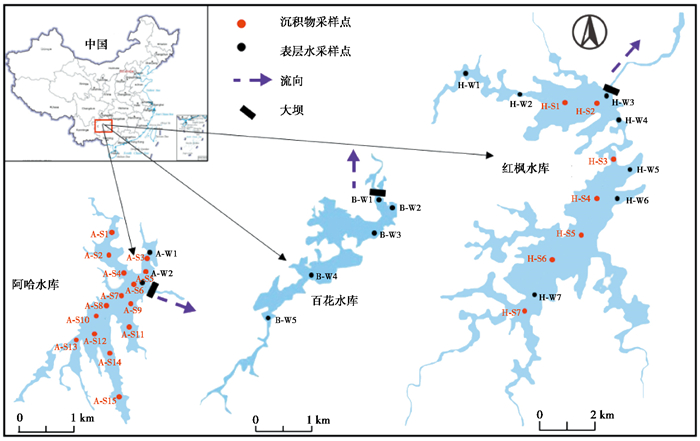
|
图 1 红枫水库、百花水库、阿哈水库的监测点示意图 Fig. 1 Schematic diagram of distribution of sampling sites in Hongfeng, Baihua and Aha reservoirs |
2009~2018年,对红枫水库7个(H-W1、H-W2、H-W3、H-W4、H-W5、H-W6、H-W7),百花水库5个(B-W1、B-W2、B-W3、B-W4、B-W5),2010~2018年对阿哈水库2个(A-W1、A-W2)代表性监测点(图 1和表 1)的水温(WT)、溶解氧(dissolved oxygen, 简称DO)进行逐月监测(红枫水库和百花水库缺失2013年8~12月DO数据),氮/磷营养盐、叶绿素a(Chl.a)采集水样后在实验室按国标方法进行逐月测定,上述数据由贵阳市两湖一库环境保护监测站提供[3~5],旨在研究揭示磷的生物地球化学循环过程、关键控制因子及其生态环境效应。
| 表 1 红枫水库、百花水库、阿哈水库监测点信息 Table 1 Information of sampling sites in Hongfeng, Baihua and Aha reservoirs |
图 2展示了近10年来红枫水库、百花水库和阿哈水库表层WT和DO浓度的时间变化特征。红枫水库库区表层WT和DO均值(范围)分别为17.9℃(5.9~27.8℃)和7.9mg/L(1.4~13.3mg/L),百花水库库区表层WT和DO均值(范围)分别为17.4℃(6.3~27.8℃)和8.0mg/L(2.3~15.6mg/L),阿哈水库表层WT和DO均值(范围)分别为17.8℃(6.3~27.4℃),8.6mg/L(3.5~18.8mg/L),均呈现出季节性和周期性变化特征。但WT和DO呈现相反变化趋势,即: 在夏季“WT最高,DO最低”,冬季则反之。夏季WT的升高主要与太阳辐射和气温的季节性变化有关,WT较高会增加水体生物呼吸速率,加速水体剖面DO的消耗。通常来说,DO会使Fe2+氧化为Fe3+,进而促进Fe3+与磷酸盐结合,则在好氧状态加速磷的吸附,厌氧状态加剧沉积物中磷的释放[27~28]。潘成荣等[29]对瓦埠湖沉积物的磷释放特征研究发现,好氧状态最大磷释放量仅为正常状况下的50 % 左右,厌氧状态磷释放量为34.3mg/kg,约为正常状况下的4倍;徐洋等[30]对红枫水库沉积物进行模拟研究发现,厌氧状态下沉积物TP浓度显著降低(降低378.9mg/kg),孔隙水中溶解态活性磷浓度有较大升高,表明厌氧条件显著促进了红枫水库沉积物磷释放;李庚辰等[31]也得到了类似结论。
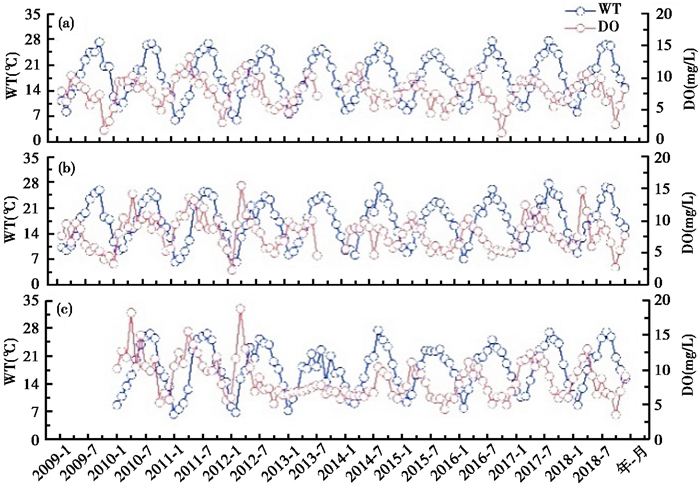
|
图 2 红枫水库(a)、百花水库(b)、阿哈水库(c)表层WT和DO浓度的变化(2009~2018年) Fig. 2 Variations of water temperature and dissolved oxygen concentration in surface water of Hongfeng (a), Baihua (b) and Aha reservoirs (c) from 2009 to 2018 |
红枫水库、百花水库和阿哈水库表层水体TP浓度均值(范围)分别为0.034mg/L(0.016~0.103mg/L),0.053mg/L(0.019~0.185mg/L)和0.046mg/L(0.022~0.205mg/L),百花水库总体高于阿哈水库,红枫水库最低(图 3)。3个水库表层水体TP浓度均呈波动式下降趋势,夏季水体TP浓度普遍高于冬季。一方面,夏季降雨量大、地表径流较为强烈,流域农业面源、工业点源等污染物质随地表径流进入水库,增加了水体磷浓度;另一方面,夏季高温条件下沉积物磷释放量比冬季低温时高[32],且夏季底层湖水处于还原状态,增强了沉积物磷的释放强度[33]。就年均值而言,红枫水库表层水体TP浓度最高值(0.078mg/L)出现在2009年,2010年之后,红枫水库表层水体TP浓度年均值迅速降低,并保持在较低水平(0.020~0.026mg/L)。2010~2018年红枫水库表层水体TP浓度年均值较2009年TP峰值下降了约67 %。百花水库表层水体TP浓度年均值变化与红枫水库类似,最大值为2009年的0.077mg/L。2012年、2014年和2017年,百花水库表层水体TP浓度出现3次峰值,2018年降低至0.044mg/L,较2009年的峰值浓度下降了约43 %。阿哈水库表层水体TP浓度年均峰值(0.073mg/L)出现在2015年,最小值(0.033mg/L)出现在2013年。
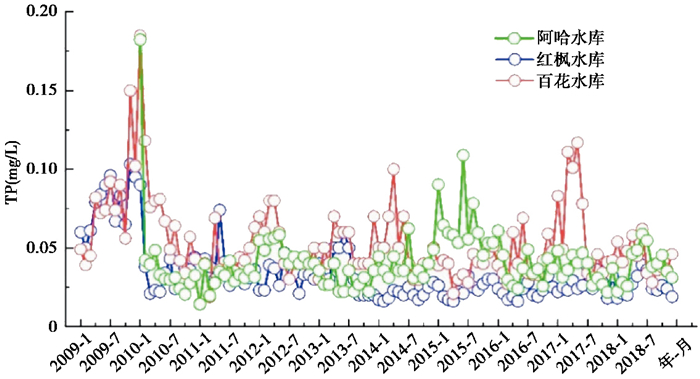
|
图 3 红枫水库、百花水库和阿哈水库表层水体TP浓度的变化(2009~2018年) Fig. 3 Variations of total phosphorus in water of Hongfeng, Baihua and Aha reservoirs from 2009 to 2018 |
基于10年的逐月监测数据,分析红枫水库、百花水库和阿哈水库表层水体TP和总氮(TN)、氨氮(NH3-N)、Chl.a浓度之间的关系。如图 4所示,3个水库表层水体TP浓度均与NH3-N浓度呈显著正相关(p<0.01),与TN/TP呈显著负相关(p<0.01)。红枫水库和百花水库表层水体TP浓度与Chl.a浓度呈显著正相关(p<0.01),而阿哈水库与其相关性不显著(p>0.05)。红枫水库表层水体TP与TN浓度呈显著正相关关系(p<0.05),而百花水库和阿哈水库表层水体TP与TN浓度相关性不显著(p>0.05)。
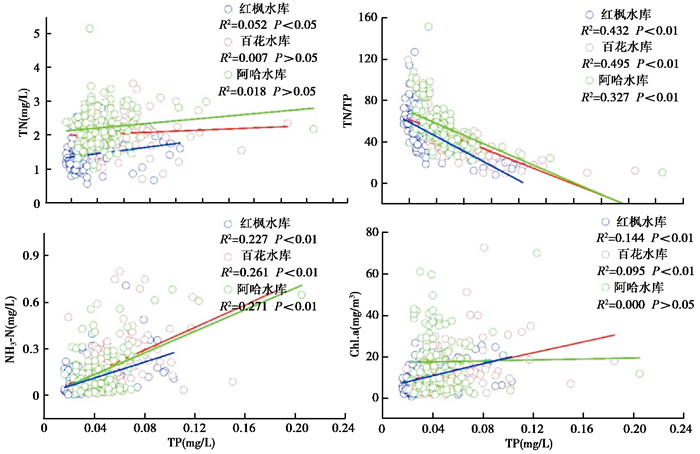
|
图 4 红枫水库、百花水库和阿哈水库表层水体TP与TN、NH3-N、Chl.a、TN/TP比值的线性关系(2009~2018年) Fig. 4 Linear relationship between TP and TN, NH3-N, Chl.a, TN/TP ratio in surface water of Hongfeng, Baihua and Aha reservoirs from 2009 to 2018 |
氮和磷被认为是浮游植物生长及藻类水华发生的重要限制因子[6, 34]。Liang等[34]通过对美国17个州1382个湖泊中水体TN和TP浓度与Chl.a浓度之间的统计分析发现,低营养型湖泊主要表现为磷限制,富营养型湖泊则表现为氮和磷共同限制,总体上TP对Chl.a比TN显示了更强的控制作用。红枫水库和百花水库表层水体TP浓度与Chl.a浓度均呈显著正相关,反映出藻类的季节性生长主要受TP浓度的影响[35]。
2.2 沉积物磷的形态、分布与释放特征 2.2.1 沉积物磷的赋存形态与空间分布沉积物作为水库磷的主要储库,表层与上覆水体直接接触,其TP含量可反映内源磷污染程度[36]。沉积物活性磷的含量决定着内源磷的潜在可释放量[32]。利用无扰动沉积物采样装置采集沉积物柱芯[37],冷干后的沉积物样品通过500℃灰化后测定其TP含量。按照化学连续提取法[38],沉积物磷主要分为5种主要形态,即弱吸附态(NH4Cl-P)、氧化还原敏感态(BD-P)、Fe/Al结合态(NaOH-P)、Ca结合态(HCl-P)和残渣态(Residual-P)。探明沉积物磷的赋存形态和时空分布特征,对评估沉积物内源磷的污染状况和潜在风险具有重要意义[22]。
中国西南地区,通过对红枫水库7个采样点(H-S1、H-S2、H-S3、H-S4、H-S5、H-S6、H-S7)和阿哈水库中15个采样点(A-S1、A-S2、A-S3、A-S4、A-S5、A-S6、A-S7、A-S8、A-S9、A-S10、A-S11、A-S12、A-S13、A-S14、A-S15)(图 1和表 1)沉积物柱芯TP含量进行分析。全年二者表层沉积物(0~5cm)中TP平均含量均超过1300mg/kg(图 5),远高于东部地区的太湖、巢湖等浅水湖泊[22, 36, 39],表明西南深水水库沉积物磷污染更为严重(图 5)。在红枫水库和阿哈水库沉积物中,Fe/Al结合态磷含量占比最高(40 % ~50 %),弱吸附态磷含量最低(0.5 % ~2.0 %)(图 5)。值得注意的是,氧化还原敏感态磷(BD-P)占TP的比例平均超过25 % (图 5)。而沉积物中活性磷(氧化还原敏感态磷: BD-P;Fe/Al结合态磷: NaOH-P;弱吸附态磷: NH4Cl-P)在TP中占比均超过50 % (图 5)。因此,在夏季分层期,底层水体缺氧可导致沉积物中大量活性磷的还原溶解,增加水体磷浓度进而增高蓝藻爆发风险[32]。前人研究发现,夏季分层期红枫水库表层沉积物TP含量明显低于冬季混合期,氧化还原敏感态磷的减少是主要原因[32, 34, 36]。总的来说,红枫水库等西南深水水库表层沉积物TP含量高,活性磷组分占比大,存在潜在的二次污染风险,未来应加强对深水水库内源磷污染的防控工作。
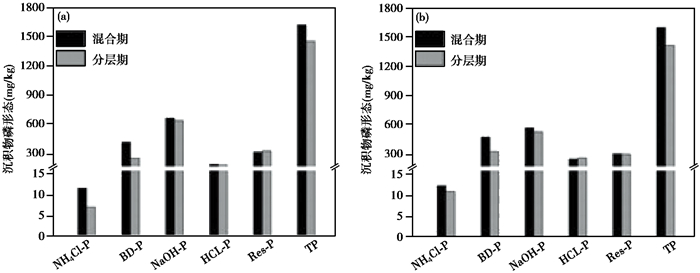
|
图 5 红枫水库(a,n=7)和阿哈水库(b,n=15)中沉积物磷形态组成特征 Fig. 5 Characteristics of sediment phosphorus fractions in Hong feng(a; n=7)and Aha reservoirs(b; n=15) |
水库磷的来源包括外源输入和内源释放两个部分[40]。在外源输入得到有效控制后,内源磷释放是水体长时间维持富营养化状态的重要原因[36, 40]。定量估算沉积物内源磷释放通量,对深入理解深水水库磷的生物地球化学循环极为重要。
Viktorsson等[41]通过原位测定法观测得到Baltic Sea芬兰湾沉积物磷释放量(高达66000t/a),是外源磷贡献量(7000t/a)的近10倍;Rydin等[42]根据沉积物剖面估算法计算了Baltic Sea内源磷潜在释放速率在1.0g/(m2 ·a) 到2.7 g/(m2 ·a) 之间;Stigebrandt等[43]通过质量平衡法估算了Baltic Sea底部缺氧区沉积物磷的释放速率(均值2.3g/(m2 ·a))。近年来,快速发展的薄膜扩散梯度技术(Diffusive gradients in thin-films technique,简称DGT)和高分辨率透析技术(HR-peeper)具备原位、高分辨率的独特优势[36, 44],通过获取沉积物-水界面间隙水磷的浓度梯度,可量化深水水库内源磷的释放通量。由于其几乎不破坏深水沉积物-水界面的性状,因此,这种技术的估算结果与真实值更为接近[44]。
Chen等[36]运用DGT和HR-peeper技术,对红枫水库、阿哈水库内源磷释放通量开展了定量研究。在夏季分层期,红枫水库和阿哈水库内源磷表观释放通量(Apparent phosphorus diffusion flux,简称AP)和净释放通量(Net phosphorus diffusion flux,简称NP)均远大于混合期(图 6)。在分层期,红枫水库的AP和NP均值高达0.29mg/(m2 ·d)、0.20mg/(m2 ·d),阿哈水库的分别为0.19mg/(m2 ·d)、0.15mg/(m2 ·d);在混合期,红枫水库AP、NP均值分别为0.11mg/(m2 ·d)、0.06mg/(m2 ·d),阿哈水库分别为0.04mg/(m2 ·d)、0.07mg/(m2 ·d)。释放的内源磷对红枫水库和阿哈水库TP贡献份额在24 % ~53 % 之间[36]。在中国东部,太湖沉积物磷的平均释放速率约为0.15mg/(m2 ·d),洞庭湖为0.09mg/(m2 ·d)[36, 39]。以上数据对比显示,相较于东部太湖等浅水湖泊,西南地区红枫水库等深水水库在夏季分层期呈现更高的内源磷释放通量。
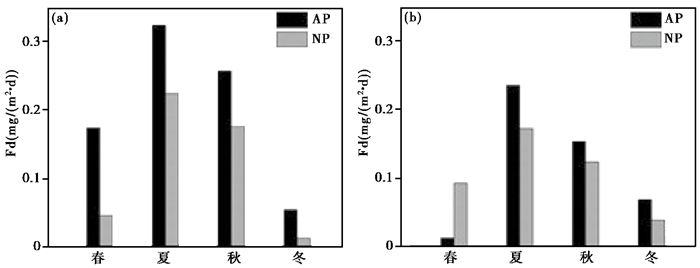
|
图 6 红枫水库(a,n=72)和阿哈水库(b,n=72)内源磷释放速率的季节变化 AP: 表观释放速率;NP: 净释放速率;72组通量数据源自文献[36, 39, 44~45] Fig. 6 Seasonal variations of internal phosphorus release rates in Hongfeng(a; n=72)and Aha(b; n=72)reservoirs. AP: Apparent phosphorus release rate; NP: Net phosphorus release rate. 72 sets of flux data were cited from references[36, 39, 44~45] |
西南深水水库沉积物内源磷释放速率较高,与其独特的地质地理背景和生态环境特征有关[26]。首先,这些水库在夏季存在明显的水体热分层,底层水体缺氧导致金属氧化物还原溶解和内源磷的快速释放[26, 36, 39];其次,在这些水库建立初期淹没了大量林地、草地、农田,底质富含有机质,建库蓄水后这些有机质的快速矿化,释放出较多的氮、磷等营养物质[26]。此外,随着国家水利水电开发和区域社会经济的快速发展,流域内的大量含磷污染物进入到水库,导致磷在库区沉积物蓄积严重,沉积物逐渐从污染物的“汇”转变为重要的“源”[26, 36]。
2.2.3 沉积物-水界面磷的释放机理前人研究发现,不同类型湖泊的沉积物磷释放过程、机理存在显著差异[36]。在浅水湖泊中,风浪扰动,极端天气事件和底栖生物活动等可导致沉积物再悬浮,氮、磷等营养盐随沉积物再悬浮进入上覆水[26];在深水水库中,沉积物-水界面的水动力通常较弱,内源磷输入主要受静态释放过程主导[36]。深水水库沉积物磷释放可分为两个阶段: 第一阶段,沉积物固相中的活性磷组分解吸进入孔隙水[46];第二阶段,孔隙水磷酸盐在化学浓度梯度的胁迫下,通过沉积物-水界面向上覆水自由扩散[45]。沉积物内源磷的释放机理,早在20世纪40年代就受到了学者的关注。Mortimer[47]首先提出铁、磷耦合循环的假设,即在好氧条件下,沉积物中大量的正磷酸盐被羟基氧化铁(FeOOH)吸附固定;当沉积物-水界面缺氧时,这些铁氢氧化物被还原为Fe2+,磷酸盐解吸进入孔隙水并向上覆水扩散。此后,众多研究结果[36, 39]支持了“铁结合态磷还原溶解主导湖泊内源磷释放”这一经典理论。但是,沉积物钙结合态磷溶解[48]、含磷有机质矿化[49]、聚磷酸盐降解[50]等过程也都伴随着磷酸盐的活化和释放。湖泊沉积物磷的释放过程不同,其主导的环境因子也不同,如,氧化还原电位(DO含量)控制着BD-P迁移和含磷有机质的矿化,pH控制着钙结合态磷的溶解[20, 36];此外,微生物活动,温度,水动力条件等环境因子也影响着磷在沉积物-水界面的迁移[36]。
深水水库沉积物磷的释放机理独具特点。Chen等[36]利用高分辨率DGT对红枫水库进行月度监测发现,季节性缺氧导致的铁结合态磷的还原溶解是沉积物内源磷释放的主要机制。冬季好氧期,铁氧化物将磷酸盐吸附,夏季缺氧期,铁氧化物被还原,磷酸盐活化释放进入上覆水[36]。类似的机制在三峡水库[51]、太湖和巢湖[39]也被发现。但在距离红枫水库仅23km的阿哈水库中,通过对分层时期沉积物中DGT-P、DGT-Fe、DGT-Mn的时空分布特征进行研究,我们发现了不同的现象。沉积物垂向剖面中DGT-Mn和DGT-P的变化趋势同步且两者间呈现极显著正相关性(r2=0.78,p < 0.001),而DGT-P和DGT-Fe无相关性(r2=0.03,p>0.05),表明沉积物中磷的释放主要由锰的氧化还原控制(图 7a)。这与很多研究揭示的Fe的氧化还原控制磷的迁移释放[36, 39, 51]有明显差异。主要因为阿哈水库沉积物中富含锰的氧化物和氢氧化物,缺氧时期锰氧化物优先作为电子受体被还原,好氧时期还原态锰再次被氧化吸附磷酸盐,进而替代铁主导了磷的地球化学循环(图 7b)。总而言之,处于不同地质地理背景的深水水库,需要针对性开展沉积物内源磷释放机制研究,从而科学指导深水水库内源磷污染的防控工作。
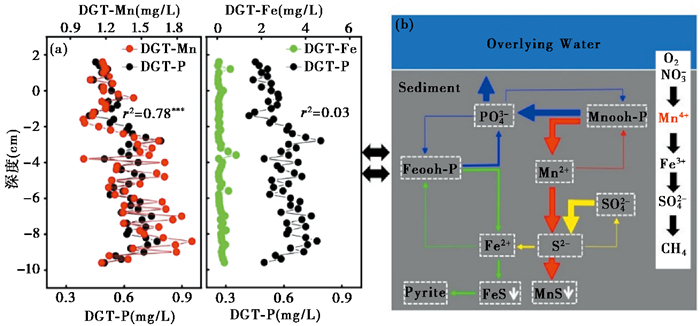
|
图 7 水库沉积物-水界面磷的地球化学循环 (a)阿哈水库沉积物-水界面DGT-Mn和DGT-P、DGT-Fe和DGT-P的分布和相关性;(b)沉积物-水界面磷-铁-锰耦合循环模型 Fig. 7 Geochemical cycling of phosphorus at the sediment-water interface in reservoirs. (a)Correlationship and profile distribution of DGT-Mn and DGT-P, DGT-Fe and DGT-P in sediment of Aha Reservoir; (b)Coupling cycle model of phosphorus, iron, and manganese at the sediment-water interface |
沉积物生物可利用磷指的是,沉积物磷中能够直接或者间接被藻类等生物所利用的活性部分,包括H2O-P、NaHCO3-P、NaOH-P[52]。其中,沉积物H2O-P是指沉积物水溶性磷(Water-soluble Phosphorus,简称WSP),其化学活性最强,是可直接被藻类等生物利用的磷形态[52];NaHCO3-P是弱碱性条件下容易释放的磷形态,其化学活性较强,是藻类可利用组分[53];NaOH-P是与Fe和Al的氧化物结合的磷组分,经过藻类短期(2 d)和长期(14 d)培养,被用来评估沉积物磷的生物可利用性[54]。
红枫水库表层沉积物生物可利用磷的3种形态含量从高到低依次为藻类可利用磷(Algal available Phosphorus,简称AAP;范围为68.6~525mg/kg,平均为394mg/kg)>NaHCO3可提取态磷(Olsen-P;范围为19.8~159mg/kg,平均为94.1mg/kg)>WSP(范围为5.8~30.6mg/kg,平均为16.4mg/kg)(图 8)[55]。从红枫水库沉积物剖面来看,随着沉积物剖面的加深,3种磷形态含量呈现出先升高后降低的趋势,并在20cm以下逐渐趋于稳定。从空间上看,红枫水库不同库区沉积物生物可利用磷存在较大差异,后午和大坝处的表层沉积物(0~20cm)生物可利用性磷含量最高,羊昌河、南湖中和北湖中次之,桃花源河最低。红枫水库沉积物AAP的含量范围为30.9~1152.4mg/kg,除桃花源外,其余点位沉积物生物可利用性磷含量较高,存在较大的沉积物磷释放风险。

|
图 8 红枫水库沉积物生物可利用磷的剖面变化[55] THY=桃花源河(Taohuayuan);NM=北湖中(North Middle);DAM=大坝(Dam);HW=后午(Houwu);SM=南湖中(South Middle);YCH=羊昌河(Yangchanghe) Fig. 8 Profiles of bioavailable phosphorus in sediment of Hongfeng Reservoir[55]. THY, Taohuayuan; NM, North Middle; DAM, Dam; HW, Houwu; SM, South Middle; YCH, Yangchanghe |
水库是我国重要的淡水资源利用形式,承载着城镇供水、防洪发电、旅游航运等多种功能。水库具有独特的地质地理背景和水环境特征以及生态系统特点[56~57],尤其其水体和沉积物磷的生物地球化学循环与浅水湖泊存在明显差异,必须深入开展研究,以科学指导其水环境保护与污染治理工作。研究不同形态磷在溶解相和颗粒相间的浓度、分布和转化的动态变化过程,可以有效揭示磷生物地球化学行为,了解磷生物地球化学循环与富营养化之间的内在联系[58]。近年来,由于梯级水电站的建立,梯级水库中磷生物地球化学循环成为一个关键问题。然而,由于缺乏长时间和空间尺度的实测水质数据,磷生物地球化学循环的研究存在一定挑战[59]。未来的重点研究方向有如下几个方面。
3.1 梯级筑坝拦截对磷生物地球化学循环的影响随着世界范围内水电开发的迅猛发展,深水水库的数量持续增长。因此,河流梯级筑坝产生的生态环境影响受到越来越多的关注。已有研究表明,大规模梯级筑坝造成全球河流输沙量大幅降低[60];同时,河流梯级筑坝对泥沙的拦截,也导致碳、氮、磷、硅等生源要素在水库中大量蓄积[61~63]。据估算,21世纪初全球水库每年埋藏48±11Tg碳[64];2000年,全球河流磷负荷的12 % 被保留在梯级水库中,到2030年,这个比例将增加到17 % [65]。长江流域是世界大坝建设最密集的流域之一,梯级筑坝对长江流域碳、氮、磷、硅生源要素的拦截效率则更高[66]。筑坝拦截对河流水体中碳、氮、磷、硅拦截效率存在明显差异,磷似乎更容易被拦截、蓄积在水库底泥中,造成下游河水中氮、磷生物可利用性的改变和近海赤潮的增加[67],因此,河流梯级筑坝对深水水库磷生物地球化学循环的影响,应当被高度重视,以便从江河流域和更大尺度上评估梯级筑坝所带来的生态环境影响。
3.2 建立量化深水水库内源磷输入通量的方法学工业废水排放、生活污水排放和农业面源污染等外源磷输入量,可以通过时间序列、周期性的采样分析获得,其估算方法较为简单。内源磷输入量的估算就复杂得多,因为沉积物位于湖泊底部,采样和观测都比较困难。而且,沉积物内源磷的释放受到沉积物自身性质[68]以及温度、pH、DO、水动力扰动、沉水植被、微生物活动等诸多环境条件的影响[69~70]。因此,定量估算沉积物磷释放通量及其贡献,仍然是当前水库营养物质管理最具挑战的问题之一。
在过去几十年来,科学家对水库内源磷输入通量的估算方法开展了长期的研究[36, 44, 47~49]。归纳起来,目前应用较为广泛的方法主要包括: 原位测量法(Benthic champers)、沉积物柱芯培养法(Sediment core incubation)、孔隙水浓度梯度法(Estimation through porewater profiles based on Fick's first law)、质量平衡法(Mass balance approach)和同位素质量平衡法(Isotopic mass balance method)。这些方法通常单一强调“总通量(gross flux)”或者“净通量(net gross)”,所适用的时间尺度、空间尺度意义亦不明晰。为深化对水库内源磷输入通量和环境意义的理解,今后需关注如下几点: 1)应强调总通量的概念,重视上覆水向沉积物的沉降通量和沉积物再悬浮与释放的研究,以便正确理解和评估内源磷输入对湖泊水体的贡献;2)应把长时间尺度(如年)与短时间尺度(如天)、大尺度(如全湖)与小尺度(如沉积物-水界面)结合考虑,根据不同的研究目的选择适宜的时间和空间尺度来进行分析;3)应重视对内源磷释放生态效应的研究,尤其是加强短时间尺度沉积物内源磷释放对藻类水华爆发的影响。
3.3 Po及其生物可利用性研究Po是水体和沉积物磷的重要组分,可占TP的10 % ~70 % [71];Po转化为Pi被认为是水体Pi的重要来源之一[72]。因此,为了深入理解磷的地球化学循环,开展水库水体和沉积物中Po组成及其生物可利用性等相关研究刻不容缓。在早期的研究中,沉积物Po含量通过沉积物TP含量减去Pi含量来获得。随着科学技术的发展,1982年,核磁共振技术(31P-NMR)首次被Tate应用来分析环境样品中的Po[73]。此后,核磁共振波普仪作为环境样品Po组成的重要分析工具,逐渐被用来分析沉积物、土壤、植物等多种环境样品[74~76]。当前,普遍采用0.25M NaOH和50mM EDTA作为土壤、沉积物和藻类等样品的Po提取剂[77],土壤等环境样品中的单脂磷、二脂磷、DNA磷、焦磷酸盐和磷酸盐可通过31P-NMR进行定性、半定量和定量检测[77],这表明31P-NMR已成为环境样品Po分析的主要手段。
水库水体和沉积物中广泛分布着各种生物酶,如碱性磷酸酶、磷酸二酯酶等,能将Po水解成Pi,进而被水生生物(微生物、藻类)利用[78]。为了探索沉积物或水体中Po的生物可利用性,许多学者将能被酶水解生成Pi的那部分Po视为生物可利用磷[14, 72]。因此,酶解技术成为研究水库Po生物可利用性的潜在有效手段。夏卓英等[79]对长江中下游湖泊沉积物碱性磷酸酶活性的研究发现,碱性磷酸酶活性从沉积物表层到底层呈现递减趋势,且不同沉积物的碱性磷酸酶活性明显不同,这可能与湖泊富营状态有关;张友等[80]发现,沉积物生物有效Po含量占总Po含量的26 % ~56 %,呈“夏秋低,冬春高”的规律。目前对于水库沉积物Po组成及其生物可利用性之间关系的研究仍不够深入,仅停留在室内模拟试验层面,今后应将室内模拟与野外调查相结合,进一步研究揭示水库沉积物Po组成、含量和生物可利用性的季节性变化及其影响因素。
3.4 水库磷循环与藻类生长的互作机制研究磷在藻类水华发生发展过程中扮演着至关重要的作用[81]。为了更好地控制藻类水华,明晰磷的藻类利用过程与机制具有重要意义。现有研究表明[82],当水体磷含量充足时,藻类会优先利用水体中的无机磷酸盐,当水体中无机磷酸盐的含量不足以维持藻类自身生长及繁殖时,藻类会分泌碱性磷酸酶促使水体中溶解性Po转化成Pi进而被藻类所利用。藻类对磷的利用方式主要有吸收和吸附,藻类吸收磷后,在自身细胞体内通常以聚磷酸盐的形式储存,而藻类对磷的吸附主要表现为磷附着在藻细胞体外;当外部条件磷(Po和Pi)含量严重缺乏时,藻类会优先利用吸附在藻类表面的磷,当外界环境中磷及藻体表面吸附的磷都严重缺乏时,藻类才会利用自身储存的磷以维持自身生命循环[82~84];此外,藻类对磷的利用除了受外界环境磷浓度、形态等的影响外,还受温度、pH、光照等影响[85]。
在深水水库,由于夏季底层缺氧及温跃层的出现会使得夏季沉积物释放的各类营养物质(碳、氮、磷)不能跃迁至表层水体[22]。在有些水库,外源氮、磷输入逐年减少,但水体却时常出现藻类水华,表明藻类对水体磷利用的周转速率很可能非常之快。研究表明,藻类群落对磷的最大吸收速率高达156μg/(L ·h ·P),最大磷释放速率为0.175μg/(L ·h ·P) [86]。水库藻类可利用的磷源包括外源磷、藻源磷(藻类代谢磷)及藻类死亡腐解所释放的磷。目前,有关藻类对磷的吸收、代谢等互作机制仍较为粗浅。
磷没有稳定同位素,但PO43-中的P-O键键能高(359.8 kJ/mol),在地表pH(近中性)、温度(<40℃)条件下与周边H2O中的O发生交换可忽略不计[87~90]。因此,磷酸盐氧同位素被用于示踪环境介质中磷的来源和生物地球化学循环[91~93]。磷酸盐氧同位素,常表示为δ18Op=(Rsample/RVSMOW-1)×1000。当有强的生物作用参与时,PO43-中的O会与H2O中的O迅速的发生交换,产生明显的同位素分馏[94]。研究表明[95],细菌等生物作用可明显的改变δ18Op组成,并朝着平衡分馏的方向发展。藻类与细菌类似,很可能会使沉积物δ18OP发生明显的动力学分馏。至今,藻类如何利用不同形态磷,以及对δ18OP组成产生什么样的影响,没有得到深入研究。利用δ18OP研究藻类等生物作用下各形态磷的同位素分馏效应,有助于理解磷的生物地球化学循环及其与藻类的互作机制和关键途径。
致谢: 感谢审稿专家和编辑部老师宝贵的修改意见,在此一并感谢!
| [1] |
Wetzel R G. Limnology: Lake and River Ecosystems[M]. San Diego, USA: Elsevier, Academic Press, 2001: 1-1006.
|
| [2] |
Singh K K, Aleya L, Singh V, et al. Disaster Management[M]. New Delhi: Aph Publishing Corporation, 2010: 1-1202.
|
| [3] |
曾华献, 王敬富, 李玉麟, 等. 贵州红枫湖近10年来(2009-2018年)水质变化及影响因素[J]. 湖泊科学, 2020, 32(3): 676-687. Zeng Huaxian, Wang Jingfu, Li Yulin, et al. Water quality change and influencing factors in Lake Hongfeng(Guizhou Province)2009-2018[J]. Journal of Lake Sciences, 2020, 32(3): 676-687. |
| [4] |
贺康康, 王敬富, 李玉麟, 等. 贵阳市百花湖近10年(2009-2018年)的水质时空变化[J]. 湖泊科学, 2021, 33(2): 494-506. He Kangkang, Wang Jingfu, Li Yulin, et al. Spatio temporal variations of water quality in Lake Baihua, Guiyang City in the past decade(2009-2018)[J]. Journal of Lake Sciences, 2021, 33(2): 494-506. |
| [5] |
曾华献, 李玉麟, 王敬富, 等. 2009-2018年贵阳市阿哈水库水质时空变化特征分析[J/OL]. 地球与环境, 2021, doi: 10.14050/j.cnki.1672-9250.2021.49.036. Zeng Huaxian, Li Yulin, Wang Jingfu, et al. Spatial-temporal variation of water quality in Aha Reservoir of Guiyang City in recent ten years(2009-2018)[J/OL]. Earth and Environment, 2021, doi: 10.14050/j.cnki.1672-9250.2021.49.036. |
| [6] |
Conley D J, Paerl H W, Howarth R W, et al. Controlling eutrophication: Nitrogen and phosphorus[J]. Science, 2009, 323(5917): 1014-1015. DOI:10.1126/science.1167755 |
| [7] |
秦伯强. 太湖生态与环境若干问题的研究进展及其展望[J]. 湖泊科学, 2009, 21(4): 445-455. Qin Boqiang. Progress and prospect on the eco-environmental research of Lake Taihu[J]. Journal of Lake Sciences, 2009, 21(4): 445-455. DOI:10.3321/j.issn:1003-5427.2009.04.001 |
| [8] |
Elsbury K E, Paytan A, Ostrom N E, et al. Using oxygen isotopes of phosphate to trace phosphorus sources and cycling in Lake Erie[J]. Environmental Science & Technology, 2009, 43(9): 3108-3114. |
| [9] |
Søndergaard M, Bjerring R, Jeppesen E. Persistent internal phosphorus loading during summer in shallow eutrophic lakes[J]. Hydrobiologia, 2013, 710(1): 95-107. DOI:10.1007/s10750-012-1091-3 |
| [10] |
范成新. 湖泊沉积物-水界面研究进展与展望[J]. 湖泊科学, 2019, 31(5): 1191-1218. Fan Chengxin. Advances and prospect in sediment-water interface of lakes: A review[J]. Journal of Lake Sciences, 2019, 31(5): 1191-1218. |
| [11] |
Westheimer F H. Why nature chose phosphates[J]. Science, 1987, 235(4793): 1173-1178. DOI:10.1126/science.2434996 |
| [12] |
高光, 朱广伟, 秦伯强, 等. 太湖水体中碱性磷酸酶的活性及磷的矿化速率[J]. 中国科学(D辑), 2005, 35(S2): 157-165. Gao Guang, Zhu Guangwei, Qin Boqiang, et al. The activity of alkaline phosphatase and mineralization rate of phosphorus in Lake Taihu[J]. Science in China(Series D: Earth Sciences), 2005, 35(S2): 157-165. |
| [13] |
Monbett P, McKelvie I D, Saefumillah A, et al. A protocol to assess the enzymatic release of dissolved organic phosphorus species in waters under environmentally relevant conditions[J]. Environmental Science & Technology, 2007, 41(21): 7479-7485. |
| [14] |
Ni Z K, Wang S R, Wang Y M. Characteristics of bioavailable organic phosphorus in sediment and its contribution to lake eutrophication in China[J]. Environmental Pollution, 2016, 219: 537-544. DOI:10.1016/j.envpol.2016.05.087 |
| [15] |
吴丰昌, 金相灿, 张润宇, 等. 论有机氮磷在湖泊水环境中的作用和重要性[J]. 湖泊科学, 2010, 22(1): 1-7. Wu Fengchang, Jin Xiangcan, Zhang Runyu, et al. Effects and significance of organic nitrogen and phosphorus in the lake aquatic environment[J]. Journal of Lake Sciences, 2010, 22(1): 1-7. |
| [16] |
秦伯强, 张运林, 杨桂军, 等. 太湖蓝藻水华"暴发"的动态特征及其机制[J]. 科学通报, 2016, 61(7): 759-770. Qin Boqiang, Zhang Yunlin, Yang Guijun, et al. Dynamics of variability and mechanism of harmful cyanobacteria bloom in Lake Taihu, China[J]. Chinese Science Bulletin, 2016, 61(7): 759-770. |
| [17] |
彭淑娴, 陈登鹏, 王嘉伟, 等. 全球变化背景下磷生物地球化学循环研究进展[J]. 环境生态学, 2020, 2(12): 1-7+22. Peng Shuxian, Chen Dengpeng, Wang Jiawei, et al. Progress in phosphorus biogeochemical cycle under global changes[J]. Environmental Ecology, 2020, 2(12): 1-7+22. |
| [18] |
季婧, 曾令晗, 卞昊昆, 等. 近50年以来的东洞庭湖沉积物中氮磷硅元素变化与区域环境演变[J]. 第四纪研究, 2018, 38(4): 1017-1023. Ji Jing, Zeng Linghan, Bian Haokun, et al. Variations in sedimentary nitrogen, phosphorus and silicon and regional environmental changes in east Dongting Lake in recent 50 years[J]. Quaternary Sciences, 2018, 38(4): 1017-1023. |
| [19] |
冯仡哲, 张虎才, 常凤琴, 等. 云南剑湖水体及表层沉积物氮、磷空间分布特征及对湖泊环境的影响[J]. 第四纪研究, 2020, 40(5): 1251-1263. Feng Yizhe, Zhang Hucai, Chang Fengqin, et al. Spatial distribution of nitrogen and phosphorus and pollution assessment in Lake Jianhu, Yunnan Province[J]. Quaternary Sciences, 2020, 40(5): 1251-1263. |
| [20] |
Barik S K, Bramha S, Bastia T K, et al. Characteristics of geochemical fractions of phosphorus and its bioavailability in sediments of a largest brackish water lake, South Asia[J]. Ecohydrology & Hydrobiology, 2019, 19(3): 370-382. |
| [21] |
王敬富, 陈敬安, 曾艳, 等. 贵州红枫湖沉积物磷赋存形态的空间变化特征[J]. 湖泊科学, 2012, 24(5): 789-796. Wang Jingfu, Chen Jingan, Zeng Yan, et al. Spatial distribution characteristics of phosphorus forms in sediment of Lake Hongfeng, Guizhou Province[J]. Journal of Lake Sciences, 2012, 24(5): 789-796. DOI:10.3969/j.issn.1003-5427.2012.05.021 |
| [22] |
Wang J F, Chen J A, Ding S M, et al. Effects of seasonal hypoxia on the release of phosphorus from sediments in deep-water ecosystem: A case study in Hongfeng reservoir, Southwest China[J]. Environmental Pollution, 2016, 219: 858-865. DOI:10.1016/j.envpol.2016.08.013 |
| [23] |
潘家铮, 陈式慧. 关于高拱坝建设中若干问题的探讨[J]. 科技导报, 1997(2): 17-19. Pan Jiazheng, Chen Shihui. Some problems on the construction of high arch dams[J]. Science & Technology Review, 1997(2): 17-19. |
| [24] |
中国水利部. 中国水资源统计年鉴[M]. 北京: 中国水利水电出版社, 2016: 1-211. Ministry of Water Resources in China. China Water Statistical Year-Book[M]. Beijing: China Water Power Press, 2016: 1-211. |
| [25] |
Mulligan M, Soesbergen A, Sáenz L. GOODD, a global dataset of more than 38, 000 georeferenced dams[J]. Scientific Data, 2020, 7(1): 31. DOI:10.1038/s41597-020-0362-5 |
| [26] |
Chen J A, Wang J F, Zeng Y, et al. Eco-environment of reservoirs in China: Characteristics and research prospects[J]. Progress in Physical Geography, 2018, 42(2): 185-201. DOI:10.1177/0309133317751844 |
| [27] |
Gomez E, Dunllon C, Rofes G, et al. Phosphate adsorption and release from sediments of brackish lagoons: pH, O2 and loading influence[J]. Water Research, 1999, 33(10): 2437-2447. DOI:10.1016/S0043-1354(98)00468-0 |
| [28] |
王锦旗, 宋玉芝, 黄进. 水温升高对水体性质及水生生物的影响研究进展[J]. 水生态学杂志, 2020, 41(1): 100-109. Wang Jingqi, Song Yuzhi, Huang Jin. Effects of increasing water temperature on water properties and aquatic organisms: A critical review[J]. Journal of Hydroecology, 2020, 41(1): 100-109. |
| [29] |
潘成荣, 张之源, 叶琳琳, 等. 环境条件变化对瓦埠湖沉积物磷释放的影响[J]. 水土保持学报, 2006, 20(6): 148-152. Pan Chengrong, Zhang Zhiyuan, Ye Linlin, et al. Effects of environmental factor on phosphorus release from sediments in Wabuhu Lake[J]. Journal of Soil and Water Conservation, 2006, 20(6): 148-152. DOI:10.3321/j.issn:1009-2242.2006.06.036 |
| [30] |
徐洋, 陈敬安, 王敬富, 等. 氧化还原条件对红枫湖沉积物磷释放影响的微尺度分析[J]. 湖泊科学, 2016, 28(1): 68-74. Xu Yang, Chen Jing'an, Wang Jingfu, et al. The micro-scale investigation on the effect of redox condition on the release of the sediment phosphorus in Lake Hongfeng[J]. Journal of Lake Sciences, 2016, 28(1): 68-74. |
| [31] |
李庚辰, 刘足根, 张敏, 等. 升温对超富营养型浅水湖泊沉积物营养盐动态迁移的影响[J]. 生态学报, 2015, 35(12): 4016-4025. Li Gengchen, Liu Zugen, Zhang Min, et al. A preliminary study of effects of warming on the nutrients dynamic in sediment of hypereutrophic shallow lake[J]. Acta Ecologica Sinica, 2015, 35(12): 4016-4025. |
| [32] |
陈洁, 许海, 詹旭, 等. 湖泊沉积物-水界面磷的迁移转化机制与定量研究方法[J]. 湖泊科学, 2019, 31(4): 907-918. Chen Jie, Xu Hai, Zhan Xu, et al. Mechanisms and research methods of phosphorus migration and transformation across sediment-water interface[J]. Journal of Lake Sciences, 2019, 31(4): 907-918. |
| [33] |
商立海, 李秋华, 邱华北, 等. 贵州红枫湖水体叶绿素a的分布与磷循环[J]. 生态学杂志, 2011, 30(5): 1023-1030. Shang Lihai, Li Qiuhua, Qiu Huabei, et al. Distribution and phosphorus cycle of chlorophyll a in Hongfeng Lake[J]. Chinese Journal of Ecology, 2011, 30(5): 1023-1030. |
| [34] |
Liang Z Y, Soranno P A, Wagner T. The role of phosphorus and nitrogen on chlorophyll a: Evidence from hundreds of lakes[J]. Water Research, 2020, 185: 116236. DOI:10.1016/J.WATRES.2020.116236 |
| [35] |
朱广伟, 秦伯强, 张运林, 等. 2005-2017年北部太湖水体叶绿素a和营养盐变化及影响因素[J]. 湖泊科学, 2018, 30(2): 279-295. Zhu Guangwei, Qin Boqiang, Zhang Yunlin, et al. Variation and driving factors of nutrients and chlorophyll-a concentrations in northern region of Taihu, China, 2005-2017[J]. Journal of Lake Sciences, 2018, 30(2): 279-295. |
| [36] |
Chen Q, Chen J A, Wang J F, et al. In situ, high-resolution evidence of phosphorus release from sediments controlled by the reductive dissolution ofiron-bound phosphorus in a deep reservoir, Southwestern China[J]. Science of the Total Environment, 2019, 666: 39-45. DOI:10.1016/j.scitotenv.2019.02.194 |
| [37] |
李键, 张维, 陈敬安, 等. 一种可实现不同水深条件下采样的湖泊沉积物柱芯采样装置[J]. 地球与环境, 2011, 39(1): 121-124. Li Jian, Zhang Wei, Chen Jingan, et al. A newly developed sampler for collecting lake sediment cores[J]. Earth and Environment, 2011, 39(1): 121-124. |
| [38] |
Hupfer M, Gaechter R, Giovanoli R. Transformation of phosphorus species in settling seston and during early sediment diagenesis[J]. Aquatic Science, 1995, 57(4): 305-324. DOI:10.1007/BF00878395 |
| [39] |
Gao Y, Tao L, Tian S, et al. High-resolution imaging of labile phosphorus and its relationship with iron redox state in lake sediments[J]. Environmental Pollution, 2016, 219: 466-474. DOI:10.1016/j.envpol.2016.05.053 |
| [40] |
Paytan A, Roberts K, Watson S, et al. Internal loading of phosphate in Lake Erie Central Basin[J]. Science of the Total Environment, 2017, 579: 1356-1365. DOI:10.1016/j.scitotenv.2016.11.133 |
| [41] |
Viktorsson L, Almroth-Rosell E, Tengberg A, et al. Benthic phosphorus dynamics in the gulf of Finland, Baltic Sea[J]. Aquatic Geochemistry, 2012, 18(6): 543-564. DOI:10.1007/s10498-011-9155-y |
| [42] |
Rydin E, Malmaeus J M, Karlsson O M, et al. Phosphorus release from coastal Baltic Sea sediments as estimated from sediment profiles[J]. Estuarine, Coastal and Shelf Science, 2011, 92(1): 111-117. DOI:10.1016/j.ecss.2010.12.020 |
| [43] |
Stigebrandt A, Rahm L, Viktorsson L, et al. A new phosphorus paradigm for the Baltic Proper[J]. Ambio, 2014, 43(5): 634-643. DOI:10.1007/s13280-013-0441-3 |
| [44] |
Davison W, Zhang H. In situ speciation measurements of trace components in natural waters using thin-film gels[J]. Nature, 1994, 367(6463): 546-548. DOI:10.1038/367546a0 |
| [45] |
Xu D, Wu W, Ding S M, et al. A high-resolution dialysis technique for rapid determination of dissolved reactive phosphate and ferrous iron in pore water of sediments[J]. Science of the Total Environment, 2012, 421-422: 245-252. DOI:10.1016/j.scitotenv.2012.01.062 |
| [46] |
Monbet P, Mckelvie I D, Worsfold P J. Combined gel probes for the in situ determination of dissolved reactive phosphorus in porewaters and characterization of sediment reactivity[J]. Environmental Science & Technology, 2008, 42(14): 5112-5117. |
| [47] |
Mortimer C H. The exchange of dissolved substances between mud and water in lakes[J]. Journal of Ecology, 1942, 30(1): 147-201. DOI:10.2307/2256691 |
| [48] |
Chen F X, Lu S Y, Jin X C, et al. Relationships of phosphorus forms in sediments of Fubao Gulf, Lake Dianchi, China[J]. Journal of Animal and Plant Science, 2015, 25(3): 190-196. |
| [49] |
Golterman H L. Phosphate release from anoxic sediments or 'what did Mortimer really write?'[J]. Hydrobiologia, 2001, 450(1-3): 99-106. DOI:10.1023/A:1017559903404 |
| [50] |
Hupfer M, Gloess S, Grossart H P. Polyphosphate-accumulating microorganisms in aquatic sediments[J]. Aquatic Microbial Ecology, 2007, 47(3): 299-311. |
| [51] |
Wang Y C, Niu F X, Xiao S B, et al. Phosphorus fractions and its summer's release flux from sediment in the China's three gorges reservoir[J]. Journal of Environmental Informatics, 2015, 25(1): 36-45. DOI:10.3808/jei.201400260 |
| [52] |
Zhou Q X, Gibson C E, Zhu Y M. Evaluation of phosphorus bioavailability in sediments of three contrasting lakes in China and the UK[J]. Chemosphere, 2001, 42(2): 221-225. DOI:10.1016/S0045-6535(00)00129-6 |
| [53] |
Zhang R Y, Wu F C, He Z Q, et al. Phosphorus composition in sediments from seven different trophic lakes, China: A phosphorus -31NMR study[J]. Journal of Environmental Quality, 2009, 38(1): 353-359. DOI:10.2134/jeq2007.0616 |
| [54] |
Dorich R A, Nelson D W, Sommers L E. Availability of phosphorus to algae from eroded soil fractions[J]. Agriculture Ecosystem & Environment, 1984, 11(3): 253-264. |
| [55] |
王敬富, 陈敬安, 杨海全, 等. 贵州红枫湖沉积物磷的生物有效性[J]. 地球与环境, 2016, 44(6): 437-440. Wang Jingfu, Chen Jingan, Yang Haiquan, et al. Bioavailable phosphorus in sediments from Lake Hongfeng, Southwestern China[J]. Earth and Environment, 2016, 44(6): 437-440. |
| [56] |
姚玲, 高全洲, 陶贞, 等. 水库水体二氧化碳分压研究进展[J]. 第四纪研究, 2019, 39(5): 1264-1275. Yao Ling, Gao Quanzhou, Tao Zhen, et al. A review of carbon dioxide partial pressure of water bodies in reservoirs[J]. Quaternary Sciences, 2019, 39(5): 1264-1275. |
| [57] |
邓颖, 陈光杰, 刘术, 等. 基于沉积物与文献记录的茈碧湖水文波动与近现代生态环境变化[J]. 第四纪研究, 2018, 38(4): 912-925. Deng Ying, Chen Guangjie, Liu Shu, et al. Sediment and historical records of hydrological fluctuation, recent environmental and ecological changes in Cibi Lake of northwest Yunnan[J]. Quaternary Sciences, 2018, 38(4): 912-925. |
| [58] |
Xu C, Dan S F, Yang B, et al. Biogeochemistry of dissolved and particulate phosphorus speciation in the Maowei Sea, northern Beibu Gulf[J]. Journal of Hydrology, 2021, 593(1): 125822. DOI:10.1016/J.JHYDROL.2020.125822 |
| [59] |
Zhang B Y, Ding W, Xu B, et al. Spatial characteristics of total phosphorus loads from different sources in the Lancang River Basin[J]. Science of the Total Environment, 2020, 722: 137863. DOI:10.1016/j.scitotenv.2020.137863 |
| [60] |
Walling D E, Fang D. Recent trends in the suspended sediment loads of the world's rivers[J]. Global and Planetary Change, 2003, 39(1-2): 111-126. DOI:10.1016/S0921-8181(03)00020-1 |
| [61] |
Chen Q W, Shi W Q, Huisman J, et al. Hydropower reservoirs on the upper Mekong River modify nutrient bioavailability downstream[J]. National Science Review, 2020, 7(9): 1449-1457. DOI:10.1093/nsr/nwaa026 |
| [62] |
Liu D, Bai Y, He X Q, et al. Changes in riverine organic carbon input to the ocean from mainland China over the past 60 years[J]. Environment International, 2020, 134: 105258. DOI:10.1016/j.envint.2019.105258 |
| [63] |
Liang X, Xing T, Li J X, et al. Control of the hydraulic load on nitrous oxide emissions from Cascade Reservoirs[J]. Environmental Science & Technology, 2019, 53(20): 11745-11754. |
| [64] |
Maavara T, Lauerwald R, Regnier P. Global perturbation of organic carbon cycling by river damming[J]. Nature Communications, 2017, 8: 15347. DOI:10.1038/ncomms15347 |
| [65] |
Maavara T, Parsons C T, Ridenour C, et al. Global phosphorus retention by river damming[J]. Proceedings of the National Academy of Sciences of the United States of America, 2015, 112(51): 15603-15608. DOI:10.1073/pnas.1511797112 |
| [66] |
Wu Z, Zhao D, Syvitski J P M, et al. Anthropogenic impacts on the decreasing sediment loads of nine major rivers in China, 1954-2015[J]. Science of the Total Environment, 2020, 739. DOI:10.1016/j.scitotenv.2020.139653 |
| [67] |
Wu G J, Cao W Z, Wang F F, et al. Riverine nutrient fluxes and environmental effects on China's estuaries[J]. Science of the Total Environment, 2019, 661: 130-137. DOI:10.1016/j.scitotenv.2019.01.120 |
| [68] |
Gonsiorczyk T, Casper P, Koschel R. Variations of phosphorus release from sediments in stratified lakes[J]. Water, Air & Soil Pollution, 1997, 99(1-4): 427-434. |
| [69] |
Qin B Q, Hu W Q, Gao G, et al. Dynamics of sediment resuspension and the conceptual schema of nutrient release in the large shallow Lake Taihu, China[J]. Chinese Science Bulletin, 2004, 49(1): 54-64. DOI:10.1007/BF02901743 |
| [70] |
Jiang X, Jin X C, Yao Y, et al. Effects of biological activity, light, temperature and oxygen on phosphorus release processes at the sediment and water interface of Taihu Lake, China[J]. Water Research, 2008, 42(8-9): 2251-2259. DOI:10.1016/j.watres.2007.12.003 |
| [71] |
霍守亮, 李青芹, 昝逢宇, 等. 我国不同营养状态湖泊沉积物有机磷形态分级特征研究[J]. 环境科学, 2011, 32(4): 90-97. Huo Shouliang, Li Qingqin, Zan Fengyu, et al. Characteristics of organic phosphorus fractions in different trophic sediments of lakes, China[J]. Environmental Science, 2011, 32(4): 90-97. |
| [72] |
Zhu Y R, Wu F C, He Z Q, et al. Characterization of organic phosphorus in lake sediments by sequential fractionation and enzymatic hydrolysis[J]. Environment Science & Technology, 2013, 47(14): 7679-7687. |
| [73] |
Tate K R, Newman R H. Phosphorus fractions of a climosequence of soils in New Zealand tussock grassland[J]. Soil Biology & Biochemistry, 1982, 14(3): 191-196. |
| [74] |
汪洪, 宋书会, 张金尧, 等. 土壤磷形态组分分级及31P-NMR技术应用研究进展[J]. 植物营养与肥料学报, 2017, 23(2): 512-523. Wang Hong, Song Shuhui, Zhang Jinyao, et al. Research advance in soil phosphorus fractionations and their characterization by chemical sequential methods and 31P-NMR techniques[J]. Journal of Plant Nutrition and Fertilizer, 2017, 23(2): 512-523. |
| [75] |
冯伟莹, 朱元荣, 吴丰昌, 等. 31P-NMR分析湖泊植物和藻类有机磷方法优化及形态研究[J]. 中国环境科学, 2016, 36(2): 562-568. Feng Weiying, Zhu Yuanrong, Wu Fengchang, et al. Optimization of extraction and parameters for 31P-NMR analysis of organic phosphorus extracted from aquatic plants and algae[J]. China Environmental Science, 2016, 36(2): 562-568. DOI:10.3969/j.issn.1000-6923.2016.02.036 |
| [76] |
张文强, 李洁, 金鑫, 等. 基于31P-NMR与SMT方法的海河流域典型河流沉积物中磷形态特征研究[J]. 环境科学学报, 2016, 36(6): 1891-1900. Zhang Wenqiang, Li Jie, Jin Xin, et al. Detection of phosphorus components in the sediments of typical river in the Haihe Basin by SMT and 31P-NMR[J]. Acta Scientiae Circumstantiae, 2016, 36(6): 1891-1900. |
| [77] |
张文强, 单保庆. 基于液相31P核磁共振(NMR)技术的巢湖沉积物中有机磷形态研究[J]. 环境科学学报, 2013, 33(7): 1967-1973. Zhang Wenqiang, Shan Baoqing. Detection of phosphorus species in the sediments of Chaohu Lake by 31P nuclear magnetic resonance spectroscopy (31P-NMR)[J]. Acta Scientiae Circumstantiae, 2013, 33(7): 1967-1973. |
| [78] |
张宇, 乌恩, 李重祥, 等. 长江中下游湖泊沉积物酶活性及其与富营养化的关系[J]. 应用与环境生物学报, 2011, 17(2): 196-201. Zhang Yu, Wu En, Li Chongxiang, et al. Enzyme activity in sediments and its relation with eutrophication in the lakes along the Yangtze River[J]. Chinese Journal of Applied and Environmental Biology, 2011, 17(2): 196-201. |
| [79] |
夏卓英, 陈芳, 宋春雷, 等. 长江中下游部分湖泊沉积物碱性磷酸酶分布及其作用研究[J]. 水生生物学报, 2007, 31(1): 9-17. Xia Zhuoying, Chen Fang, Song Chunlei, et al. A study on distribution and roles of alkaline phosphatase in sediments of some lakes in the middle and lower reaches of the Yangtze River[J]. Acta Hydrobiologica Sinica, 2007, 31(1): 9-17. DOI:10.3321/j.issn:1000-3207.2007.01.002 |
| [80] |
张友, 宋佳伟, 吕迎春, 等. 荣成天鹅湖沉积物有机磷的生物有效性及其时空动态[J]. 环境科学学报, 2017, 37(12): 184-190. Zhang You, Song Jiawei, Lü Yingchun, et al. Bioavailability and variations of organic phosphorus in sediments of Swan Lake, Rongcheng[J]. Acta Scientiae Circumstantiae, 2017, 37(12): 4629-4635. |
| [81] |
Ren L X, Wang P F, Wang C, et al. Algal growth and utilization of phosphorus studied by combined mono-culture and co-culture experiments[J]. Environmental Pollution, 2017, 220: 274-285. DOI:10.1016/j.envpol.2016.09.061 |
| [82] |
Ma J J, Wang P F, Ren L X, et al. Using alkaline phosphatase activity as a supplemental index to optimize predicting algal blooms in phosphorus-deficient lakes: A case study of Lake Taihu, China[J]. Ecological Indicators, 2019, 103: 698-712. DOI:10.1016/j.ecolind.2019.04.043 |
| [83] |
Feng W Y, Yang F, Zhang C, et al. Composition characterization and biotransformation of dissolved, particulate and algae organic phosphorus ineutrophic lakes[J]. Environmental Pollution, 2020, 265(part B): 114838. DOI:10.1016/j.envpol.2020.114838 |
| [84] |
Yao B, Xi B D, Hu C M, et al. A model and experimental study of phosphate uptake kinetics in algae: Considering surface adsorption and P-stress[J]. Journal of Environmental Sciences, 2011, 23(2): 189-198. DOI:10.1016/S1001-0742(10)60392-0 |
| [85] |
张胜花, 常军军, 孙珮石. 水体藻类代谢及藻体矿化研究进展[J]. 生态环境学报, 2013, 22(7): 1250-1254. Zhang Shenghua, Chang Junjun, Sun Peishi. Phosphorus cycle of algae during its growth and death process: Phosphorus uptake and release[J]. Ecology and Environmental Science, 2013, 22(7): 1250-1254. DOI:10.3969/j.issn.1674-5906.2013.07.027 |
| [86] |
Prentice M J, Hamilton D P, Willis A, et al. Quantifying the role of organic phosphorus mineralisation on phytoplankton communities in a warm-monomictic lake[J]. Inland Waters, 2019, 9(1): 1-15. DOI:10.1080/20442041.2018.1508115 |
| [87] |
Blake R E, O'Neil J R, Surkov A V. Biogeochemical cycling of phosphorus: Insights from oxygen isotope effects of phosphoenzymes[J]. America Journal of Science, 2005, 305(6/8): 596-620. |
| [88] |
Lecuyer C, Grandjean P, Sheppard S M F. Oxygen isotope exchange between dissolved phosphate and water at temperatures lower than or equal to 135 degrees celcius: Inorganic versus biological fractionations[J]. Geochimica et Cosmochimica Acta, 1998, 63(6): 855-862. |
| [89] |
O'Neil J R, Vennemann T W, McKenzie W F. Effects of speciation on equilibrium fractionations and rates of oxygen isotope exchange between (PO4)aq and H2O[J]. Geochimica et Cosmochimica Acta, 2003, 67(17): 3135-3144. DOI:10.1016/S0016-7037(02)00970-5 |
| [90] |
Tamburini F, Bernasconi S M, Angert A, et al. A method for the analysis of the δ18OP of inorganic phosphate extracted from soils with HCl[J]. European Journal of Soil Science, 2010, 61(6): 1025-1032. DOI:10.1111/j.1365-2389.2010.01290.x |
| [91] |
Mclaughlin K, Silva S, Kendall C, et al. A precise method for the analysis of δ 18 O of dissolved inorganic phosphate in seawater[J]. Limnology & Oceanography Methods, 2004, 2(7): 202-212. |
| [92] |
Tian L Y, Guo Q J, Zhu Y G, et al. Research and application of method of oxygen isotope of inorganic phosphate in Beijing agricultural soils[J]. Environmental Science Pollution Research, 2016, 23(23): 23406-23414. DOI:10.1007/s11356-016-7482-7 |
| [93] |
Pistocchi C, Tamburini F, Gruau G, et al. Tracing the sources and cycling of phosphorus in river sediments using oxygen isotopes: Methodological adaptations and first results from a case study in France[J]. Water Research, 2017, 111: 346-356. DOI:10.1016/j.watres.2016.12.038 |
| [94] |
Granger S J, Heaton T H E, Pfahler V, et al. The oxygen isotopic composition of phosphate in river water and its potential sources in the upper River Taw catchment, UK[J]. Science of the Total Environment, 2017, 574: 680-690. DOI:10.1016/j.scitotenv.2016.09.007 |
| [95] |
Stout L M, Joshi S R, Kana T M, et al. Microbial activities and phosphorus cycling: An application of oxygen isotope ratios in phosphate[J]. Geochimica et Cosmochimica Acta, 2014, 138: 101-116. DOI:10.1016/j.gca.2014.04.020 |
2 University of Chinese Academy of Sciences, Beijing 100049)
Abstract
China's hydropower resources rank first in the world. The large number of cascade reservoirs formed by the intensive hydropower development is one of the most important storage forms of freshwater resources in China. In these reservoirs, the sources, biogeochemical cycles and its eco-environmental effects of phosphorus (P) have their own characteristics, but the related research is scare. In this study, taking typical reservoirs(Hongfeng(26°26'~26°35'N, 106°19'~106°28'E), Baihua(26°35'~26°41'N, 106°27'~106°32'E) and Aha(26°30'~26°34'N, 106°37'~106°40'E) reservoirs with areas of 57.2km2, 14.5km2 and 3.4km2, and average depths of 10.5m, 10.8m and 13.0m in Southwest China) as examples, the P fraction in the sediment, the P concentration of the water, and the water quality parameters were determined respectively by chemical sequential P extraction method, spectrophotometric method and a multi-parameter water quality monitor(YSI 6600-V2, YSI Inc., Yellow Springs, USA). The occurrence forms, temporal and spatial variation characteristics, migration and transformation rules and bioavailability of P in reservoir water and sediment were systematically clarified. The results indicated that: (1) With the development of national water environment protection, the concentration of total phosphorus(TP) in reservoir water(0.02~0.21mg/L) presents a continuous decreasing trend; (2) In the reservoir water, Chl.a was significantly positively correlated with TP concentration, indicating that algae growth in the reservoirs was still mainly controlled by TP; (3) Compared with the eastern shallow reservoirs, the TP content in reservoir sediments in Southwest China is usually higher(mean>1300mg/kg), in which the proportion of active P components(redox sensitive P: BD-P, Fe/Al bound P: NaOH-P, loosely adsorbed P: NH4Cl-P) accounts for more than 50%; (4) High resolution observation showed that the reservoirs have higher internal P release rates(0.15~0.29mg/(m2·d)) in summer stratification period, which was much higher than that of shallow lakes in Eastern China(0.09~0.15mg/(m2·d)); (5) Seasonal anoxia induced reductive dissolution of Fe/Mn bound P is the key mechanism of internal P release from sediments. In addition, the significance of the study on the biogeochemical cycle of P in reservoirs was emphasized, and the future research direction was proposed. 2021, Vol.41
2021, Vol.41
